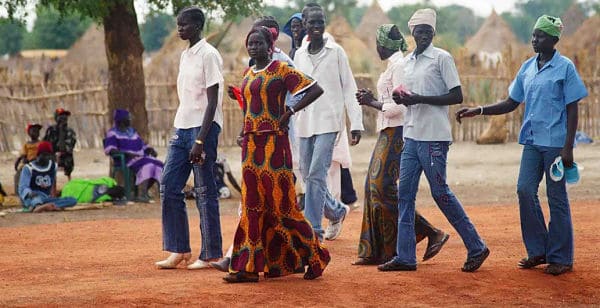Stories of war, violence, running and survival were a common narrative of many South Sudanese Nuer whom I met first in Egypt in 2002, and later in Khartoum, Kenya and South Sudan. The turmoil of the second Sudanese civil war (1983-2005) to the Sudanese and the Nuer in particular caused traumatic changes in their lives. Many among the four million displaced women and men during the 22-year long civil wars in Sudan (1983-2005) had spent most of their lives in refugee camps in Kenya and Ethiopia. In the aftermath of the 2005 peace agreement between the Sudanese government in Khartoum and the Sudan People’s Liberation Army-Movement (SPLA/M) – the main South Sudanese rebel organisation – they repatriated to post-war South Sudan. A place they barely remembered or knew was supposed to become ‘home’. Yet, due to their diverse experiences during wars and flight and the changes that took place in South Sudan, they often felt estranged within their own ‘homes’. When after years of displacement some of them arrived in Lεr, a county capital in South Sudan’s Unity state and Upper Nile region, they were faced with the uncertainty of finding long-lost relatives, settling in and confronting local expectations of ‘proper behaviour’ as ‘real’ Nuer women and men.
This book follows the efforts of 17 Nuer families and over 50 additional individuals who escaped ‘home’ due to violence and wars that tore their communities apart, were displaced throughout Sudan and East Africa and eventually settled in a refugee camp in Kenya. In the process, their lives were irreversibly changed in unexpected and differentiated ways. Years and decades later, in the aftermath of repatriation, they and their relatives and friends who were displaced elsewhere or who had stayed behind come together to (re)create and (re)build a home, a community and a nation.
The stories of lives fragmented by wars, experienced in several contexts and pieced together in the aftermath of wars are seldom told. The narratives of those displaced and those who had stayed behind reveal the complexity of social change in the context of forced displacement and nation-building.
By conceptualising conflict-induced displacement as a catalyst of social change, I explore the transformation of gender and generational relations among South Sudanese Nuer in the context of refugee return and ‘emplacement’ in the aftermath of the second civil war (1983-2005). Based on multi-sited ethnographic research in Kakuma refugee camp in Kenya and in South Sudan between April 2006 and September 2007, this book narrates and analyses the experience of gendered and generational displacement of the group of Nuer women and men whom I followed.

The coming together of the displaced populations from the variety of exile contexts and their encounter with those who had stayed behind exposed the tensions in the visions of (re)making of Nuer community and South Sudanese nation.
To understand the centrality of war, displacement and livelihood strategies – amongst other things – in defining South Sudanese Nuer meanings of daily life, this book uses the metaphor of ecological seasons as thought of and lived by the Nuer. As elder women and men often told me, they continue to be closely linked to their environment, landscape and cattle despite changes that have taken place in their lives. In the past, ecological constraints influenced their social relations in an environment with a distinctive rhythm of backwards and forwards movement from villages to cattle camps: the Nuer’s response to the climatic dichotomy of rains and drought. This continues to be a case for those Nuer women and men who still rely on cattle herding and agriculture, especially those who had stayed behind in villages during the wars. The elder women and men whom I encountered in Kakuma refugee camp in Kenya in 2006 and in South Sudan between 2006 and 2007 explained that the year (ruon) has two main seasons, tot (rain) and mai (drought). They also pointed out to two transitional periods between tot and mai, rail (movement from camp to village) and jiom (wind – movement from village to camp). Throughout my stay in South Sudan, women and men, young and old used these terms to identify changes in both ecological conditions but also their changing ways of life throughout the year. Each period serves as a metaphor of a different stage of displacement and settling in after return.
The stories and narratives of displacement and emplacement follow the cyclical Nuer migration from jiom – war-induced displacement, through mai – life in Kakuma refugee camp, to rwil – return to Lεr in South Sudan and tot – when life concentrates in the village.
Why is it important to focus on gender and generational aspects of displacement and refugee experience?
Forced displacement, exile and uprootedness – due to conflict, natural disasters or so-called development and climate change – are conditions that mark the lives of millions of people throughout the world. As reported by UNHCR on Refugee Day in June 2014, “the number of refugees, asylum-seekers and internally displaced people worldwide has, for the first time in the post-World War II era, exceeded 50 million people. (….) 51.2 million people were forcibly displaced at the end of 2013, fully 6 million more than the 45.2 million reported in 2012.” UNHCR office in Sudan estimates over 1000 asylum seekers from Eritrea every month. With the failed protection systems of their own countries and neighbouring countries, displaced women and men take on the dangerous journeys across Sahara and the Mediterean into Europe to seek refuge beyond their continent. With the ongoing conflicts in the Ukraine, Syria, Palestine, South Sudan, Iraq, just to mention a few, the focus on war-time displacement is of particular importance. Violent displacement involves people living on the edge of urban slams or in refugee camps. Here the ‘deserving poor’ are faced with the gendering effects of humanitarian assistance. For decades, they live in a state of suspension. Such drastic displacement affects (albeit differently) women and men, old and young, and changes their lives dramatically. The visions for the future and the imagined ‘homes’ that women and men are longing for are shaped based on their experiences in the specific framework of refugee camps.
Forced mobility of populations, whether in the context of displacement or return, is becoming more prevalent in recent years. There is an urgent need for more careful reconsiderations of the role of the humanitarian community in creating the ‘refugee subjects’ and shaping their visions of ‘return’ and long-term nation-building.
I focus on the camp-based displacement to draw attention to the particularities of NGO and UN humanitarianism and their long-term impact on returnee’s efforts to (re)create a community and a nation.
Furthermore, gender and generation are dimensions of displacement and refugee experience that have been largely overlooked both in academic writings as well as in policy and programming. Earlier focus on gender in refugee experiences was mainly concerned with experiences of women, without deeper analysis of the relational aspects of gender and the influence of gender norms, institutions and ideologies on the shifting position of women and men within a society. In this book, I ask whether war and displacement can have empowering and emancipating impacts, questioning gender asymmetries existing within the societies. How does being ‘in-flux’ between war, prolonged displacement – sometimes for decades – belonging, not belonging and returning to a supposed ‘home’ – affect people’s lives and the practice and negotiation of gender relations?
Being ‘in-flux’ refers here not only to being ‘out of place’ from one’s own environment due to war, but also to transforming cultural practices in refugee camps and after return. A closer look at the experiences of the displacement and emplacement after ‘return’ reveals how women and men continuously negotiate and reshape their gender identities and generational relations in and between the different settings of displacement and emplacement. In particular, I analyse how Nuer women and men, old and young, navigated the social conditions of war and violence and used their agency to adjust, adapt and negotiate their place in exile and after their return ‘home’.
My book demonstrates that during violent civil conflicts masculine and feminine identities change in multiple ways. Gender asymmetrical relations are challenged differently in conflict-zones, refugee camps and in the processes of emplacement and nation building after return.
I argue that women’s subordination was partially reversed as a result of the Sudanese civil wars. Consequently, multiple forms of gender identities emerged showing creative ways in which women and men cope with war-time displacement, beyond being either only victims or perpetrators of violence. In post-war South Sudan, I show how militarised forms of masculinities and violence affected femininities clash against ‘educated pro-women’ men and ‘empowered educated women’ that emerged due to experiences in the refugee camp. While lesser opportunities exist for women to reverse their subordination vis-a-vis men upon return to South Sudan, they actively contest, resist and (re)negotiate old and new hegemonies (of male privilege).

This book is also timely given the most recent civil war that erupted in South Sudan on 15 December 2013, when fighting broke out between the pro-government forces aligned with President Salva Kiir and opposition groups associated with the former Vice-President, Riek Machar. There are competing narratives about the events of the new conflict. Many commentators dubbed the violence as ethnically motivated, between Dinka and Nuer groups. Yet, this explanation skims over the deeper tensions and the more fragile and complex alliances that emerged as a result of the December crisis. The violence spread from Juba to Unity and Jongolei, and further to Equatoria. At first, Bentiu, Lεr and Malakal were strongholds of the anti-government forces. However, government forces slowly but surely reclaimed these areas. As a result, Bentiu and Lεr were razed by both retreating rebels and advancing government forces. By October 2014, the United Nations estimated that close to 2 million people had been displaced across and outside of South Sudan,with large numbers seeking protection in UNMIS bases. Around 493,000 refugees had crossed into Ethiopia, Kenya, Sudan and Uganda.[1]
Once again, women became primary recipients of indiscriminate violence and subjected to displacement, yet their voices were excluded at the peace talks in Addis Ababa. At the beginning of February, in response to the destruction of lives, homes and livelihoods across South Sudan, women from various ethnic groups staying in the UNMIS protection site in Bentiu marched twelve kilometres in silence, holding white flags, to the Governor’s office. They demanded that displaced women be engaged in peace processes. This initiative was undertaken by displaced Nuer and Dinka women who also sought to open up inter- and intra-community dialogues to address the conflicts in Unity state. ‘We are women of peace, we have come together – Nuers, Dinkas and Equatorians – to promote peace and reconciliation’, said Aluel Wal Magor, a 40-year old mother of nine. ‘We met with the state governor [Dr Joseph Nguen Monytuil] to tell him that we do not buy the idea of being divided along ethnic lines’.
Lεr and other places where I carried out my ethnographic research no longer exist. They were burned to the ground, reportedly by government forces in the beginning of February 2014. Nyakuol, Nyariek, Kuok and others whom I followed during the research in Kakuma and in South Sudan have become displaced yet again. Some have lost their lives, and some are once again refugees in Kakuma. The refugee cycle continues.
[1] UNHCR, ‘South Sudan Emergency Situation’, 5 February, UNHCR External Regional Update, 2012.
Katarzyna Grabska. Gender, Home & Identity: Nuer repatriation to Southern Sudan. 2014. Suffolk: Currey. 240 pp. Pb. £45.00. ISBN: 9781847010995








